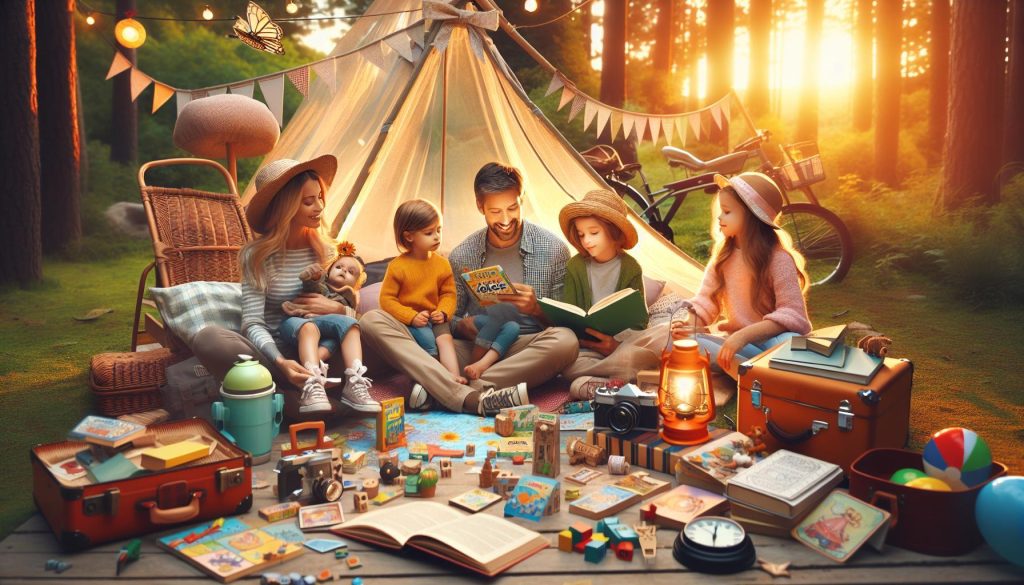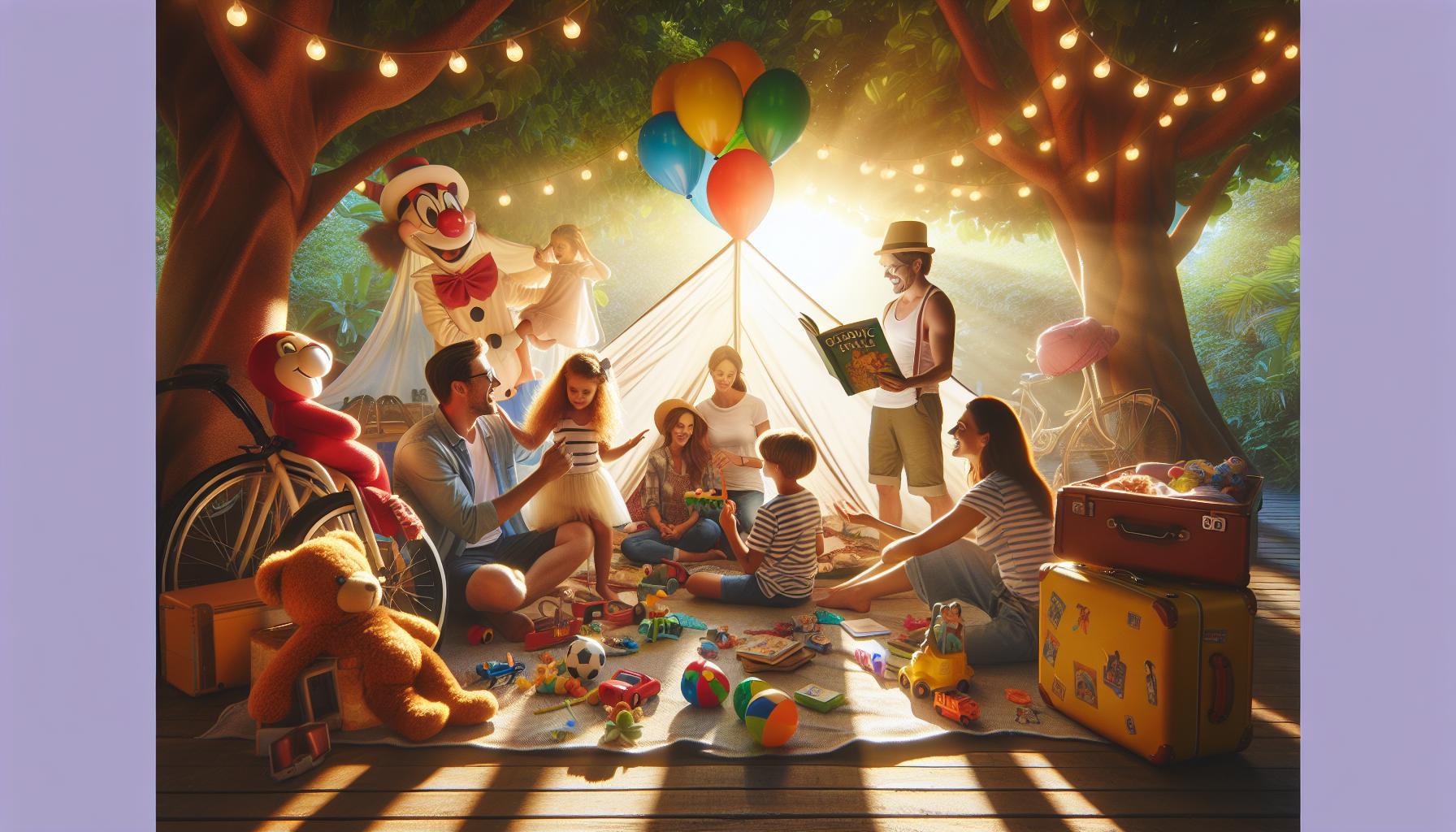Fairy Tale Jokes for Kids to Bring Stories to Life with Laughter
Get ready to turn storytime into giggle time! If you’ve ever wondered how to make your little ones squeal with laughter while they dive into the magical world of fairy tales,you’re in for a treat.“Fairy Tale Jokes for Kids to Bring Stories to Life with Laughter” is your go-to guide for blending creativity and humor. From clever quips about cackling witches to tail-wagging puns involving heroic hounds,these jokes will not only tickle your child’s funny bone but also add a delightful twist to their favorite bedtime stories. So grab your crown, slip on those glass slippers, and join us on this whimsical journey where laughter reigns supreme and fairy tales come alive in the most delightful way!
Understanding the Importance of Humor in Fairy Tales
Fairy tales have long been a staple of childhood storytelling, captivating audiences with their whimsical characters and enchanting plots. However,the addition of humor transforms these timeless tales,infusing them with an element of relatability that resonates particularly well with young listeners. Humor not only serves to entertain but also engages children, making them more excited about the stories being told. When a child laughs,they are more likely to retain the lessons and morals embedded in the tales,fostering a deeper connection to the narrative.
Incorporating humor into fairy tales can take many forms. Here are a few examples of how humor enhances these beloved stories:
- Character Archetypes: Comical characters, such as bumbling villains or wise-cracking sidekicks, can create laughable situations that entertain while simultaneously propelling the storyline.
- Playful Language: Silly rhymes, puns, and playful dialogues can make the reading experience more enjoyable, allowing children to engage with the language.
- Unexpected Twists: Humor often stems from the element of surprise; when a story takes an unexpected turn, it can evoke laughter, making the tale more memorable.
To illustrate the role of humor in fairy tales, consider the following table highlighting popular fairy tales and their humorous elements:
| Fairy Tale | Humorous Element |
|---|---|
| The Three Little pigs | The wolf’s comically exaggerated attempts to blow down the houses. |
| Goldilocks and the Three Bears | Goldilocks’ mischief and the bears’ shocked reactions. |
| Jack and the Beanstalk | Jack’s lazy decision-making leading to absurd confrontations with the giant. |
Moreover, laughter plays a notable role in emotional growth. Research suggests that when children laugh,they can express their feelings more freely,which helps them navigate the complex emotions depicted in fairy tales. As children hear stories filled with humor, they learn to approach life’s challenges with a lighter heart, seeing obstacles as opportunities for giggles rather than just struggles. This ability to find humor in situations is an invaluable life skill, enhancing their problem-solving capabilities and emotional resilience.
Exploring Classic Fairy Tales and Their Comedic Elements
Classic fairy tales have long been a source of enchantment, weaving together fantastical characters, moral lessons, and unforgettable narratives. However, beneath their surface of magic and wonder lies a treasure trove of comedic elements that can make these stories even more engaging for a young audience. Through exaggeration, unexpected twists, and witty dialog, humor breathes new life into classic tales, transforming them into delightful experiences that resonate with children.
Many fairy tales incorporate absurd situations and playful characters that lend themselves to comedy. For example, consider the tale of Jack and the Beanstalk, where a young boy encounters a giant who is more comical than terrifying. The humorous interplay between Jack’s cleverness and the giant’s blundering nature provides a perfect backdrop for jokes like:
- Why did Jack climb the beanstalk? Because he heard the giant had a “goose” that laid golden eggs!
- What did the giant say when he lost his job? “I can’t believe I was let go. I was at the top of my field!”
Another example can be found in the story of Little Red Riding Hood, where the humorous dialogues between characters add a playful twist to the narrative. The wolf, frequently enough portrayed as sly and cunning, can become a source of laughter for kids when faced with clever retorts from Little Red. Some light-hearted jokes include:
| Setting | Joke |
|---|---|
| Little Red Riding Hood’s Path | Why did Little Red Riding Hood always carry a basket? Because the wolf wouldn’t stop asking for snacks! |
| The Wolf’s Plan | What did the wolf say after he tried on Little Red Riding Hood’s cloak? “I look good enough to be on the ‘Wool’ fashion show!” |
By integrating laughter into these timeless narratives, children not only better connect with the stories but also develop a love for literature early on. Through the joyful merging of humor and classic fairy tales, parents and educators can create lasting memories that resonate for years to come.
How to Craft Your Own Fairy Tale Jokes for Kids
Creating your own fairy tale jokes is a splendid way to ignite imagination while enjoying laughter. Start by identifying classic fairy tale characters or themes that children are familiar with. This could include iconic figures like princesses, dragons, talking animals, or wicked witches. Once you have your characters, think about their quirks and the silly situations they might find themselves in.
Here are some tips to get you started:
- Play with Wordplay: Use puns or clever twists on words. For example, why did the fairy bring a ladder? Because she wanted to reach new heights!
- Incorporate Rhymes: Rhyming jokes can be catchy and fun. For instance, what’s a dragon’s favorite exercise? Flame-robics!
- Draw from Fairy Tale Tropes: Jokes often work well when they reference familiar story elements. Why did the prince break up with the princess? Because she was always a little *too* high maintenance!
When writing jokes, remember the importance of simplicity. Keep the language age-appropriate and ensure that the punchline is clear to avoid confusion. A small table could help organize ideas by character and type of joke:
| Character | Joke Type | Example Joke |
|---|---|---|
| Giant | Pun | What did the giant order at the café? A *huge* serving of pancakes! |
| Witch | Rhyme | What does a witch say when she’s mad? “You’ll be *stirred*, not shaken!” |
| Wolf | Play on Words | Why doesn’t the wolf use the computer? As he’s afraid of the *menu*! |
Encourage kids to get involved by brainstorming their own ideas, making it a collaborative activity. This can not only refine their creativity but also strengthen their storytelling skills.Whether it’s through family gatherings or classroom activities, sharing these jokes will create a happy, laughter-filled atmosphere and bring fairy tales to life in a delightful way!
Top Fairy tale Jokes that Will delight Children of All Ages
Fairy Tale Jokes to Spark Laughter
brighten up story time with these whimsical fairy tale jokes that are sure to tickle the funny bones of kids and parents alike! Whether you’re recounting tales of brave knights, cunning wolves, or magical beasts, injecting humor can bring a new level of joy to classic stories. Here are some delightful jokes that promise to captivate kids of all ages:
- Why did Cinderella get kicked off the soccer team? Because she kept running away from the ball!
- What did the Big Bad Wolf wear when he did his laundry? A little “bo peep” fabric softener!
- Why couldn’t the princess play hide and seek? Because good luck hiding when you have a giant pea under your mattress!
- What’s Rapunzel’s favorite type of hair product? Anything that keeps her “tangled”!
| Character | Favorite Food | Funny Joke |
|---|---|---|
| Snow White | Poisoned Apple | Why did she eat it? She was feeling a little “down in the orchard”! |
| Pinocchio | Wooden Cookies | Why did he refuse dessert? He just wanted to “be real!” |
| Hansel & Gretel | Gingerbread | Why couldn’t they ever find their way home? Because they kept “snacking” on the path! |
with each joke, the characters we love transform from timeless figures into relatable friends, making laughter an essential ingredient in the world of fairy tales. Share these jokes with your kids, and watch as they dive into the magical realm of stories with a luminous smile and a hearty giggle!
Using Fairy Tale Jokes to Enhance Reading and Storytelling Skills
Integrating humor into fairy tales can substantially enhance children’s reading and storytelling abilities. by incorporating fairy tale jokes, children are encouraged to engage with the text on a deeper level, creating a more interactive and enjoyable reading experience.when children laugh at jokes related to their favorite stories, it fosters a connection to the narrative, helping them to recall plot points, characters, and morals more effectively.
Here are some key benefits of using fairy tale jokes in reading:
- Stimulates Interest: Jokes can spark curiosity, making children more excited to read the story fully to understand the context behind the humor.
- Encourages Comprehension: Humor often relies on understanding character traits or story arcs, which can deepen comprehension as children make connections between the jokes and the story.
- Builds Vocabulary: Exploring the punchlines frequently enough requires children to think critically about word usage and meanings, ultimately expanding their vocabulary.
- Enhances Memory Retention: Associating jokes with specific tales reinforces memory, as children are likely to remember both the jokes and the lessons from the story.
| Fairy Tale | Example joke |
|---|---|
| Goldilocks and the Three Bears | Why did Goldilocks go to the bear’s house? She heard it was a “bare” necessity! |
| Little Red Riding Hood | what did Little Red Riding Hood say when she saw the big bad wolf? “what big teeth you have!” “All the better to eat your jokes!” |
| The Princess and the pea | What did the princess say when she found the pea? “I’m afraid I’m too ‘pea-ty’ to sleep!” |
Incorporating these jokes into storytelling can also transform the dynamic of reading sessions. Parents and educators can take advantage of this humor by pausing after a joke to discuss its meaning or how it relates to the story. This not only promotes discussion but also makes reading a collaborative and enjoyable activity, encouraging children to share their own insights and jokes, thereby fostering a love for literature that lasts long beyond the pages of any book.
Incorporating Jokes into Interactive Storytime Sessions
Incorporating humor into storytime sessions can transform conventional storytelling into an interactive and memorable experience for children. By seamlessly blending jokes with fairy tales, educators and parents not only engage young listeners but also stimulate their imaginations. Humor acts as a bridge, making stories more relatable while also encouraging kids to think critically about narrative elements.
Here are some effective strategies to weave jokes into your storytime:
- Choose Relevant Jokes: Select jokes that coincide with the themes or characters of the fairy tales. Such as, if telling the story of “Jack and the Beanstalk,” introduce a joke like: “Why did Jack take a ladder to the bar? Because he heard the drinks were on the house!”
- Pause for Punchlines: create suspense by pausing at strategic moments before delivering the punchlines. This not only enhances engagement but allows kids to anticipate the humor.
- Encourage Participation: Invite children to share their own jokes or predict a funny twist in the story.This reinforces active listening and makes them feel part of the storytelling process.
Here’s a quick reference table showcasing some fairy tale-themed jokes that can be leveraged during your sessions:
| Fairy Tale | Joke |
|---|---|
| Cinderella | Why did Cinderella get kicked off the soccer team? She kept running away from the ball! |
| Little Red Riding Hood | What did little Red Riding Hood say to the wolf? “You’re not the only one with wild ideas!” |
| The Three little Pigs | Why did the third pig build his house out of bricks? He wanted something that wouldn’t just blow away with the wind! |
By combining laughter with imaginative storytelling, you foster a dynamic learning environment where children are excited to explore tales in new and engaging ways. Remember,the goal is not just to tell a story but to create an interactive atmosphere filled with joy and laughter.
The Benefits of Laughter: Why Fairy Tale Jokes Matter for Child Development
Laughter is more than just a joyful sound; it’s a powerful tool that significantly impacts child development. When children engage with fairy tale jokes, they not only enjoy the stories but also enhance their cognitive and emotional growth. Here are some key benefits of incorporating humor through fairy tale jokes into children’s lives:
- Cognitive Development: Jokes stimulate creativity and critical thinking. Children learn to recognize patterns and develop a sense of timing, which can enhance their problem-solving skills.
- Emotional Intelligence: Humor promotes empathy and social interaction. By understanding jokes and sharing laughter, kids learn to relate better to others, fostering deeper connections and improving their emotional regulation.
- Language Skills: Fairy tale jokes frequently enough play with words and concepts, providing children with a fun way to expand their vocabulary. They start understanding puns and double meanings, which enhances their language comprehension.
- stress Relief: Laughter acts as a natural antidote to stress. During challenging times, sharing a joke can lighten the mood, making children feel more secure and confident in their environment.
Furthermore, incorporating fairy tale jokes into storytelling can create a more engaging narrative, strengthening children’s interest in reading and storytelling. Consider this simple table that highlights some classic fairy tale humor:
| Fairy Tale | Joke |
|---|---|
| Little red Riding Hood | Why did Little Red Riding Hood take a ladder to the forest? As she heard the wolf was a high-risk predator! |
| The three Bears | Why was Goldilocks so good at basketball? Because she always found the right bear! |
| Cinderella | Why did Cinderella get kicked off the soccer team? Because she kept running away from the ball! |
Integrating laughter into play and learning not only ignites imagination but also equips children with essential life skills, helping them grow into well-rounded individuals. The joyful experience of fairy tale jokes creates a sense of belonging and happiness, making the world of stories more vibrant and relatable.
Q&A
What are fairy tale jokes and why are they important for kids?
Fairy tale jokes are light-hearted, often pun-filled quips that relate to classic stories and characters from fairy tales. They serve a dual purpose: entertaining children and enhancing their understanding of narrative elements. By connecting humor with familiar tales, these jokes not only evoke laughter but also deepen children’s engagement with literature. Research has shown that humor can enhance memory retention, making jokes an effective tool for learning.In a world where digital distractions are prevalent, fairy tale jokes can spark a child’s interest in reading and storytelling. For instance, a joke like, “Why did Cinderella get kicked off the soccer team? Because she kept running away from the ball!” not only elicits a giggle but also references a well-known character and plot. This connection encourages children to share the joke with others, fostering social interaction and cooperative play through laughter.
How can fairy tale jokes be used in educational settings?
Fairy tale jokes can be integrated into various educational settings as a fun method to promote literacy, critical thinking, and creativity among young learners. Teachers can use these jokes during reading sessions, encouraging students to create their own jokes based on the stories they read. This process enhances comprehension skills and stimulates imaginative thinking, crucial elements in developing literacy.
Incorporating humor into lesson plans can also create a more relaxed classroom atmosphere. As a notable example, educators can start a class with a fairy tale joke, allowing students to share their responses before diving into more complex topics like plot analysis or character development. Such interactions not only break the ice but also encourage participation from all students, thus promoting a sense of belonging.
Can fairy tale jokes help develop children’s social skills?
Absolutely! Fairy tale jokes can significantly contribute to the development of children’s social skills. When children share jokes, they practice vital communication techniques, such as timing, delivery, and understanding an audience’s reaction. this exchange fosters a sense of community as they bond over shared laughter,encouraging friendships and enhancing group dynamics.
Moreover, humor plays a crucial role in social interactions. Children learn to read social cues and understand the appropriateness of sharing jokes in various contexts. For example, telling a fairy tale joke during playtime or circle time can show them when and where humor is acceptable, contributing to their emotional intelligence. In a group setting, this collaborative sharing of jokes creates an inclusive environment, promoting cooperative learning and emotional connections among peers.
What age group is most suitable for fairy tale jokes?
Fairy tale jokes are particularly suited for children aged 5 to 12 years. At this age, children not only begin to understand the structure of jokes but also have a burgeoning interest in classic stories and characters. Younger children (5-7) may enjoy simple puns, while slightly older kids (8-12) can appreciate wordplay and more refined humor. This progression in humor parallels their developmental milestones in cognitive and social skills.
Choosing age-appropriate jokes is essential for maximizing enjoyment and understanding. For younger kids, straightforward jokes such as “What did the big bad wolf order at the restaurant? the grilled cheese! ” work effectively as of their simplicity. In contrast, older children might prefer jokes that involve a more intricate understanding of the fairy tale’s plot or characters, like “Why was the giant so good at gardening? Because he had a lot of thyme!” This ensures that humor continues to engage and entertain as they mature.
How can parents incorporate fairy tale jokes into family activities?
Parents can easily incorporate fairy tale jokes into family activities to create a joyful atmosphere at home. One simple method is to establish a “joke of the day” routine where family members take turns sharing their favorite fairy tale jokes during dinner or family game nights. This not only adds laughter to everyday activities but also encourages conversation and bonding over shared humor.Additionally, parents can create themed story times where they read a fairy tale followed by related jokes. This approach reinforces the story and its themes while providing a fun way to connect with the material. Such as, after reading “Jack and the beanstalk,” they might follow up with a joke like, “What did Jack say to the magic beans? ‘I’m just here to grow a little!’” incorporating humor in reading practices can make the stories more memorable and enjoyable, instilling a love for literature in children.
What are some popular fairy tale jokes to get started?
For those looking to dive into the world of fairy tale jokes, here are a few popular examples that children typically enjoy:
- What does a fairy tale princess use to keep her hair in place? A hair castle!
- Why did Little Red Riding Hood stop carrying a basket? She found it wasn’t a good “basket” case!
- How did the frog feel when he had a broken leg? Unhoppy!
- Why was the broom late? It swept in!
These jokes serve as a fantastic starting point for kids, sparking their creativity and encouraging them to share or even create their own variations. By initiating laughter around these familiar stories, children can appreciate the humor in storytelling and the joy it brings to their everyday lives.
The Way Forward
As we’ve explored in this article, fairy tale jokes are not just a fun way to lighten the mood—they’re a brilliant tool for sparking creativity and enhancing comprehension in children. Humor intertwined with storytelling can reinforce key themes, promote critical thinking, and even aid in vocabulary development. As a notable example,when kids laugh at a pun involving Little Red Riding Hood,they’re not just enjoying a chuckle; they’re engaging with the narrative in a way that fosters retention and deeper understanding.
By sharing these jokes with the young ones in your life,you’re not only bringing joy to their favorite tales but also enriching their cognitive and social skills. So, whether you’re telling old classics or contemporary spins on fairy tales, remember to sprinkle in a few laughs. After all, as the saying goes, “Laughter is the best medicine”—and when paired with captivating stories, it can be truly magical! Happy storytelling!





